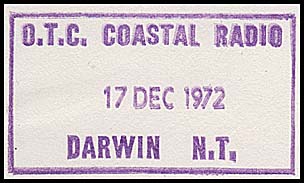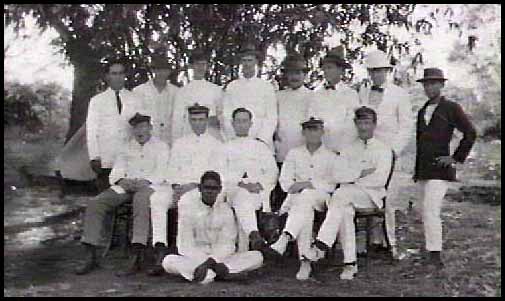Coastal Wireless Stations - Darwin.
- Australia 1901-1988
- New South Wales
- Queensland
- South Australia
- Tasmania
- Victoria
- Western Australia
- International
- Special aspects
| Call sign: VID | |
| Opened: 25 September 1913. | Closed: 1931. |
| Location: In Frog Hollow near the junction of Wireless Hill Road, McMinn Street and Daly Street. | |
| Transferred to: Parap in 1950. | |
In December 1912, Mr. Graham, from the PMG's Wireless Telegraphy section visited Darwin " to choose suitable sites for the erection of two wireless stations. One of these will be a small power station for use chiefly in maintaining communication with shipping. It will be an important link in the chain of wireless stations that have either been completed or are now in course of erection right round Australia, and by means of which ships sailing all around this coast will be enabled to keep within touch of civilisation - for the trend of latter day developments is that all passenger carrying ships of any note must shortly be equipped with wireless apparatus. When the complete scheme is perfected, it should minimise the dangers of sea travel to a great extent and in many ways and it can be easily understood that it should also prove a most important factor in facilitating defensive tactics if ever Australia should be in the unhappy position of being assailed by some overseas enemy".
Northern Territory Times - 12 December 1912.
Two developments relevant to Darwin Radio were:
- an intermediate station was being considered to link up with Thursday Island. Cape Wessel, in the Gulf of Carpentaria, was the selected site. Ultimately this proposal was abandoned;
- it was believed that the Portuguese authorities were planning to erect a wireless station at Timor Island. If they had proceeded with this plan, the numerous islands in the Malayan Archipelago and ships sailing therein would have been brought "within the magic circle".
Conditions for messaging to and from Darwin were very difficult - especially in the wet season. Indeed, on occasions, it was even difficult to communicate with ships in Darwin Harbour.
Front L-R: Stewart, K: Brown, Percy; Father Fanning; Allinson, L; Reynolds, G. Seated in front 'Frog' the head waiter |
The Radio Operators at Darwin on 1 May 1918. Taken at the Monastery Mess. Courtesy of the Northern Territory Library: |
 |
Date stamp for the Darwin Coastal Radio Station.
Established by AWA in 1913. Transferred to OTC in the late 1940s. |
Within a short time after A.W.A. assumed responsibility for the Coastal Radio Service in 1922, Darwin became the contact point for the many outstations on properties, missions, etc in the Northern Territory. In the early days, these outposts used "pedal-power" for their radio broadcasts although these were later replaced with teleradios.
In April 1929, Darwin Radio played an important part in linking Canberra with the North-West of Australia when the airliner Canberra found the missing Southern Cross with its crew of Charles Kingsford-Smith, Charles Ulm, McWilliams and Litchfield all safe. They had left Sydney on March 30 and had been trying to fly to England in 13 days.
During World War 2, Darwin was used as a link in the Royal Australian Navy's Coast Watching Scheme to report enemy activity. Darwin Radio was bombed in two raids in 1942 - in June and in August.
